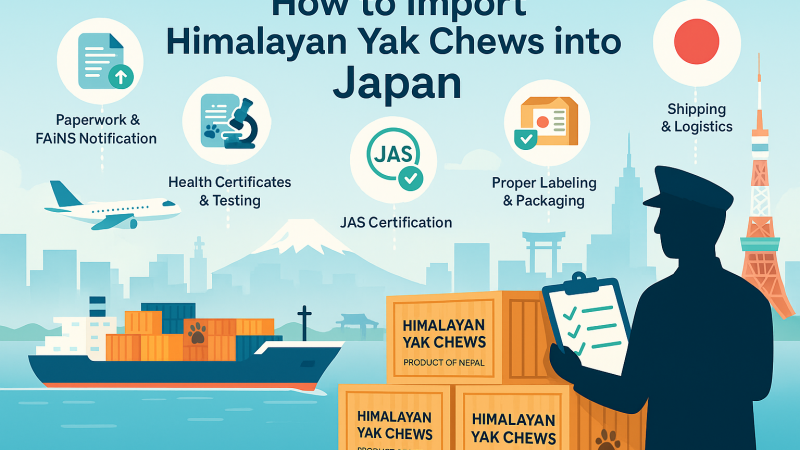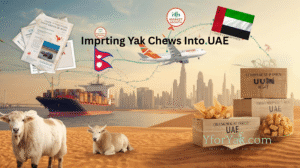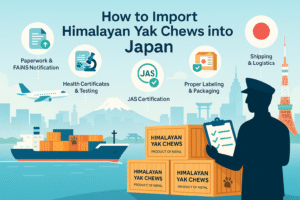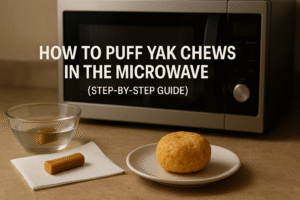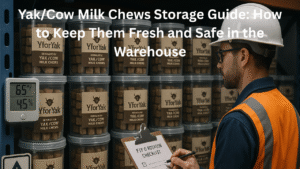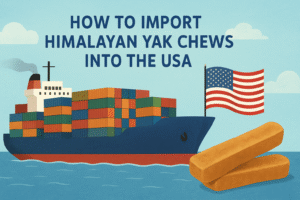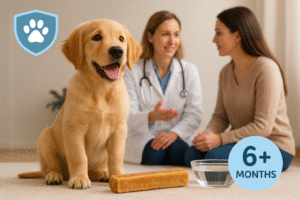So, you’re thinking about bringing Himalayan yak chews into Japan for your pet business? That’s great! These chews are pretty popular. But, like anything you want to sell in Japan, there are rules. It’s not just about having a good product; you also need to make sure it meets all the local requirements. This guide will walk you through what you need to know to successfully import Himalayan yak chews into Japan, from understanding the paperwork to getting them on the shelves.
Key Takeaways
- Japan has specific rules for pet food and animal products, so check the Food Sanitation Law and the Pet Food Safety Law.
- You’ll need to submit import notifications, usually through the FAINS system, and your products will go through a quarantine and inspection process.
- Make sure your yak chews meet animal quarantine standards and have the correct health and safety certificates from the country of origin.
- Accurate labeling in Japanese is a must, covering ingredients, allergens, and origin, and proper packaging is needed to keep the chews fresh.
- Working with a licensed customs broker can really help sort out all the necessary documents and clear customs without too much hassle.
Navigating Japanese Import Regulations for Pet Products
Bringing pet products like Himalayan yak chews into Japan means you’ve got to get familiar with some pretty specific rules. It’s not just about having a good product; it’s about making sure it fits perfectly within Japan’s legal framework for food and animal products. This section breaks down the main laws and standards you’ll need to pay attention to, so your yak chews don’t hit any unexpected roadblocks.
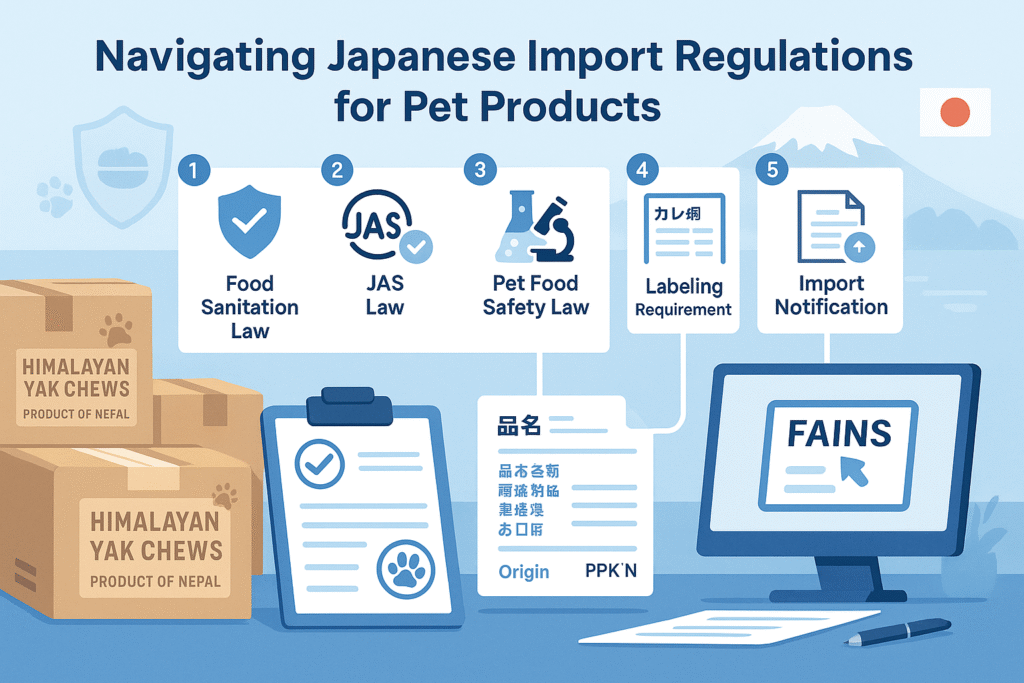
Japan takes food safety seriously, and that extends to pet treats. The primary law here is the Food Sanitation Law. It’s designed to make sure that anything people or pets consume is safe and doesn’t contain harmful stuff. For your yak chews, this means they need to be free from contaminants and meet certain safety standards. You’ll also need to make sure your product labeling is clear and in Japanese, listing things like the product name, what’s inside, any potential allergens, how much there is, and where it came from. Before your shipment even arrives, you’ll need to submit an import notification to the quarantine station. This is how Japan checks that your yak chews are up to snuff with their food safety rules.
Beyond general food safety, there’s the Japan Agricultural Standards (JAS) Law. This law sets the bar for agricultural products, and that includes pet treats. It covers quality, composition, and how things should be labeled. If you want your yak chews to be recognized as meeting these standards, you might look into JAS certification. This can be a real plus for market acceptance. The JAS system has different categories, like general JAS for quality and composition, and organic JAS if that applies to your product. There are also specific JAS standards for unique production methods and testing methods. Getting familiar with these can help you position your product effectively.
Then there’s the Pet Food Safety Law, which is pretty straightforward: it’s all about making sure pet food is safe and labeled correctly. This law, overseen by the Ministry of the Environment and the Ministry of Agriculture, Forestry and Fisheries, sets limits for things like aflatoxin B1 and certain pesticides. It also has rules for other potential contaminants like mycotoxins and heavy metals, as well as additives. Your yak chews will need to meet these specific quality and safety benchmarks to be legally sold in Japan. It’s a good idea to have testing done to confirm your product aligns with these requirements. In this Importing Himalayan Yak Chews into Japan, YforYak Dog Chew Export service can Help you.
Essential Import Notification and Quarantine Procedures
Before your yak chews can even think about hitting the shelves in Japan, there are a couple of big hurdles to clear: getting the right paperwork filed and passing through quarantine. It sounds a bit daunting, but it’s all about making sure what you’re bringing in is safe and sound. This process is non-negotiable for any animal product imports.
Submitting Import Notifications via FAINS System
Think of the FAINS (Food Automated Import Notification System) as Japan’s digital gateway for imports. You’ll need to submit your import notification through this online system before your yak chews arrive. It’s where you tell the authorities what you’re bringing in, where it’s from, and that you’ve done your homework on meeting their standards. Getting this done correctly and on time is key to avoiding any hold-ups at the port.
Mandatory Quarantine and Inspection Process
Once your shipment lands, it enters a mandatory quarantine and inspection phase. This is where Japanese officials will take a close look at your yak chews. They’re checking for any signs of disease, contaminants, or anything that might pose a risk to animal or human health. This isn’t just a quick glance; it can involve sampling, lab tests, and a review of all your submitted documents. It’s a thorough check to make sure your product is up to snuff.
Obtaining Certificate of Notification for Customs Clearance
If your yak chews pass the quarantine inspection with flying colors, you’ll be issued a Certificate of Notification. This little piece of paper is your golden ticket. It’s the official stamp of approval that says your product has met Japan’s import requirements. You’ll need this certificate to clear customs and officially get your yak chews into the country for distribution. Without it, your shipment isn’t going anywhere.
Specific Requirements for Yak chew / Animal Product Imports
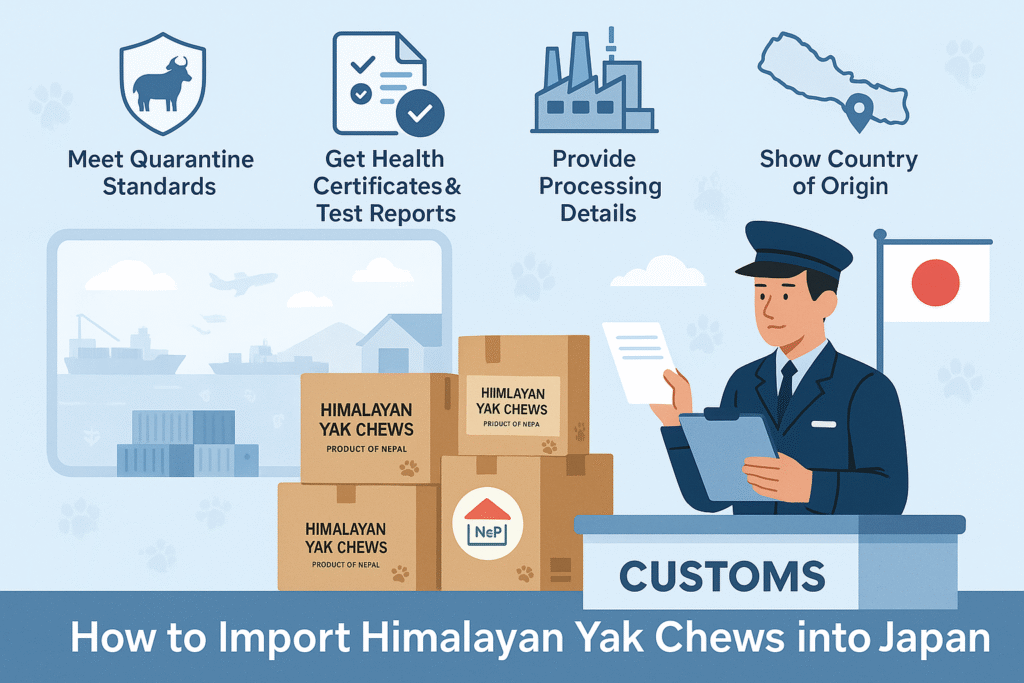
When you’re bringing animal-derived products like Himalayan yak chews into Japan, there are some extra hoops to jump through. It’s all about making sure these items are safe and don’t introduce any unwanted pests or diseases. Think of it as a health check for your product before it hits the shelves.
Meeting Animal Quarantine Standards
Japan takes animal health pretty seriously, and for good reason. Products that come from animals, especially cloven-hoofed ones like yaks, need to meet specific quarantine standards. This is to prevent the spread of animal diseases. You’ll need to show that your yak chews are free from any pathogens that could be a problem. This usually involves getting documentation from the country of origin that confirms the animals were healthy and the processing was done in a way that minimizes risk. It’s a key step to get past the initial checks.
Required Health Sanitary Certificates and Test Reports
To prove your yak chews meet the necessary health and safety benchmarks, you’ll need official paperwork. This typically includes a Health Certificate and possibly other test reports. These documents should be issued by the relevant government authority in the country where the yak chews are produced. They act as a stamp of approval, verifying that the product adheres to the safety standards Japan expects. Without these, your shipment could face significant delays or even be turned away. Getting these documents right is super important for a smooth import process.
Ensuring Compliance with Japanese Quality Standards
Beyond just health and safety, your yak chews also need to align with Japan’s general quality standards for pet products. This means looking at things like ingredient quality, processing methods, and overall product integrity. While specific standards for yak chews might not be as detailed as for human food, they still need to be safe and of good quality for pets. You might need to provide information about the ingredients and how the chews are made. It’s about showing that you’re not just importing a product, but a quality product that Japanese pet owners will trust. This is where understanding the Japanese Agricultural Standards (JAS) can be helpful, even if your product doesn’t carry the mark itself, as it sets a benchmark for quality.
“The process for importing animal products requires careful attention to detail. Gathering the correct health and quarantine documentation upfront can save a lot of trouble down the line. It’s better to be over-prepared with your paperwork than to face unexpected issues at customs.”
Here’s a quick rundown of what you might need:
- Health Certificate: Issued by the exporting country’s veterinary or agricultural authority.
- Test Reports: Potentially including tests for contaminants or pathogens, depending on specific requirements.
- Processing Information: Details about how the yak chews are made, to demonstrate adherence to safety protocols.
- Country of Origin Documentation: Proof of where the product originated and was processed.
Quality Assurance and Certification for Yak Chews
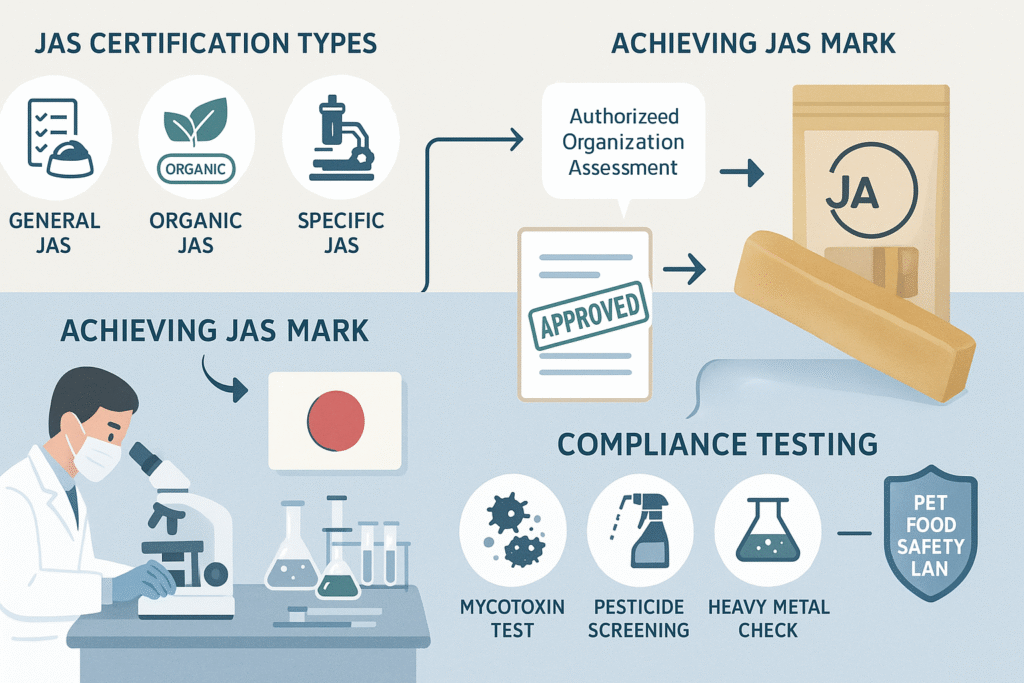
When you’re bringing yak chews into Japan, making sure they’re top-notch is a big deal. It’s not just about having a good product; it’s about proving it meets Japan’s high standards. This involves understanding specific certifications and making sure your chews pass any required tests. Getting this right means your product will be welcomed by Japanese consumers and their pets.
Understanding Japanese Agricultural Standards (JAS)
The Japanese Agricultural Standards, or JAS, are a set of guidelines designed to ensure quality and safety for various agricultural products, including pet treats like yak chews. There are different types of JAS certifications:
- General JAS: This applies to foods and forestry products, covering aspects like quality, composition, and specifications.
- Organic JAS: This is for products that are marketed as ‘organic’.
- Specific JAS: This category is for products made using unique or specialized methods.
- Testing-Method JAS: This relates to test reports that have been analyzed using official JAS methods.
Achieving JAS Certification for Product Labeling
While not always mandatory for all imported pet products, obtaining JAS certification can be a significant advantage. It allows you to use the official JAS mark on your product packaging. This mark signals to consumers that your yak chews have met specific quality and safety criteria set by the Japanese government. To pursue this, you’ll need to work with authorized organizations that can assess your product against the relevant JAS standards. This process often involves detailed documentation and product analysis. You can find more information and contact details for inquiries through the Standards and Conformity Assessment Policy Office.
Implementing Compliance Testing and Quality Assurance Measures
Beyond JAS, you need to be prepared for other compliance checks. Japan has strict rules under the Pet Food Safety Law, which sets limits for things like aflatoxin B1 and certain pesticides. Your yak chews will likely undergo inspections and testing to confirm they meet these requirements. This might include checks for mycotoxins, heavy metals, and other additives. It’s wise to conduct your own internal quality assurance testing before shipping to catch any potential issues early. This proactive approach helps avoid delays and ensures your product is safe and high-quality for the Japanese market. Being ready for these tests is part of the Foreign Supplier Verification Programs that Japan expects.
Accurate Labeling and Packaging for the Japanese Market
Getting your yak chews ready for Japan means paying close attention to how you label and package them. It’s not just about making them look good; it’s about following specific rules to make sure they get through customs without a hitch. This is a really important step for any importer.
Meeting Japanese Labeling Regulations
When you’re labeling your yak chews for Japan, you’ve got to include certain information. Think of it like a checklist. You’ll need the product name, a list of all the ingredients, any potential allergens, the net weight or quantity, and where the product came from – the country of origin. And yes, all of this needs to be in Japanese. It sounds like a lot, but it’s how they keep things clear and safe for consumers. It’s also a good idea to have a clear ingredient certificate ready, just in case.
Adhering to Pet Food Safety Law Labeling Requirements
Beyond the general labeling rules, Japan’s Pet Food Safety Law has its own set of requirements. This law is all about making sure pet food is actually safe. So, your yak chew labels need to be super accurate about the ingredients and what the product is made of. They also set limits for things like certain toxins or heavy metals, so your label needs to reflect that your product meets these standards. It’s all about transparency and safety for our furry friends.
Implementing Specialized Packaging and Temperature Control
How you package your yak chews matters a lot, especially for the journey to Japan. You want packaging that keeps the chews in good shape, preventing them from breaking or getting damaged. For some products, especially if they’re sensitive, you might even need to think about temperature control during shipping. This could mean using special containers that keep a consistent temperature. It’s all about making sure the yak chews arrive in Japan just as fresh and appealing as when they left.
Here’s a quick look at what you might need:
- Product Name (in Japanese)
- Full Ingredient List (in Japanese)
- Allergen Information (in Japanese)
- Net Content (weight/quantity)
- Country of Origin
- Compliance statements related to the Pet Food Safety Law
“Keeping your product quality high during transit is just as important as meeting the regulatory requirements. Think about how the product will be handled and stored from the moment it leaves your facility until it reaches the Japanese market. This attention to detail can make a big difference in avoiding issues down the line, and it helps build trust with your customers in Japan. It’s a good idea to look into options for importing pet food into Canada if you plan to expand your market later, as similar principles of safety and labeling apply [e6c9].”
Choosing the right packaging can also help with efficient unpacking once the shipment arrives. Making sure cartons are clearly labeled with product details can prevent mix-ups and speed up the process at your facility.
Choosing the Right Shipping and Logistics Strategy
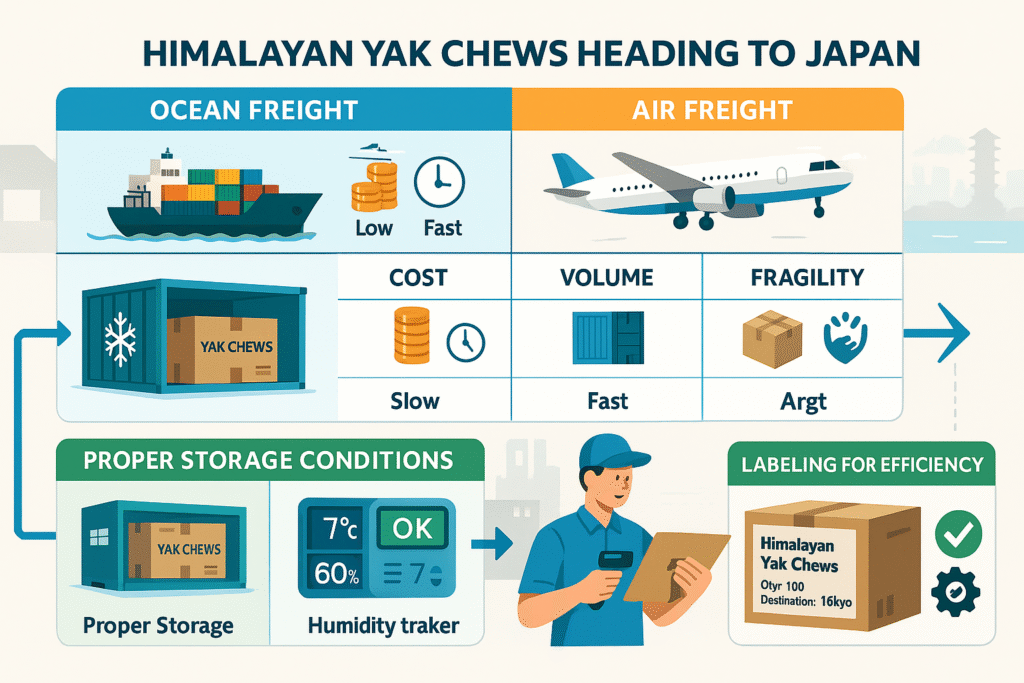
So, you’ve got your yak chews ready to go, but how do you get them to Japan without a hitch? This is where picking the right shipping and logistics plan really matters. It’s not just about getting them there; it’s about them arriving in tip-top shape, ready for eager pets.
Evaluating Ocean Freight vs. Air Freight Options
When it comes to moving your yak chews across the globe, you’ve got two main choices: ocean freight or air freight. Ocean freight is generally the more budget-friendly option, especially for larger quantities. It’s slower, though, so you need to factor that into your timeline. Think of it like sending a postcard versus a package – one takes its sweet time, the other gets there faster. Air freight, on the other hand, is quicker but comes with a higher price tag. If you’re on a tight schedule or dealing with a particularly sensitive product, air freight might be your best bet. For smaller shipments, air freight is often the way to go.
Here’s a quick look at the trade-offs:
| Feature | Ocean Freight | Air Freight |
| Cost | Lower | Higher |
| Speed | Slower | Faster |
| Volume | Suitable for large, bulk shipments | Better for smaller, time-sensitive shipments |
| Fragility | Requires robust packaging | Generally gentler handling |
Maintaining Proper Storage Conditions During Transit
This is a big one. Yak chews, like many natural pet products, can be sensitive to temperature and humidity. You don’t want them getting stale or, worse, developing mold. Maintaining the right conditions throughout the journey is key to product quality. If you’re shipping a large volume, consider using refrigerated containers. It’s a good idea to make sure the container has a temperature tracker installed so you can monitor the conditions remotely. This helps prevent any nasty surprises when your shipment finally arrives. The Pet Yak Cheese Chews Market is expected to grow, so keeping your product in good condition is important for customer satisfaction.
Affixing Proper Labels for Efficient Unpacking
Once your yak chews land in Japan, they’ll need to be processed. Making sure the boxes are clearly labeled helps a ton with this. Think about what information someone unpacking the shipment will need at a glance – product name, quantity, destination within your facility, maybe even a handling instruction. Affixing proper labels on the cartons avoids confusion about product details while unpacking at your facility. It might seem like a small detail, but good labeling can save a lot of time and prevent mix-ups, especially if you’re importing a variety of products. It’s all part of making the whole import process smoother, from the moment it leaves the warehouse to when it’s ready for sale.
“Proper labeling isn’t just about meeting regulations; it’s about operational efficiency. Clear, accurate labels on each box streamline the receiving process, reduce the chance of errors, and help your team manage inventory more effectively. It’s a simple step that pays off significantly in the long run.”
Working with Customs Brokers for Smooth Import
Okay, so you’ve got your yak chews ready to go, all the paperwork is mostly in order, but now comes the part where you actually get them through Japanese customs. This is where a good customs broker can be a real lifesaver. Trying to figure out all the ins and outs yourself? Yeah, that’s a recipe for headaches and delays. These folks know the system, and they can help make sure your shipment doesn’t get stuck in limbo.
Partnering with Licensed Customs Brokers
Think of a customs broker as your guide through the maze of import rules. They’re professionals who deal with this stuff every single day. They know exactly what forms need to be filled out, which boxes need ticking, and how to talk to the right people at customs. It’s not just about having the documents; it’s about having them correctly and submitted in the right way, at the right time. A good broker can prevent costly mistakes and keep your yak chews moving towards their destination.
Ensuring All Documentation and Certification is in Order
This is where the broker really earns their keep. They’ll double-check everything. You’ll need a bunch of papers, and they’ll make sure you have them all. This usually includes:
- Invoice
- Packing List
- Health Certificate (from the exporting country)
- Quarantine Certificate
- Shipper’s Declaration for non-dangerous goods
- Import Notification (often submitted via the FAINS system)
They’ll also confirm that any required test reports or specific certifications for animal products are present and accounted for. It’s all about having a complete, accurate package to present to Japanese authorities. If something’s missing or incorrect, your shipment could be held up, or worse, sent back. That’s definitely not what you want when you’re trying to get your product to market.
Dealing with customs can feel like trying to solve a puzzle with missing pieces. A customs broker has the full picture and knows how to put it all together, making the whole process much less stressful for you.
Key Documentation for Importing Yak Chews
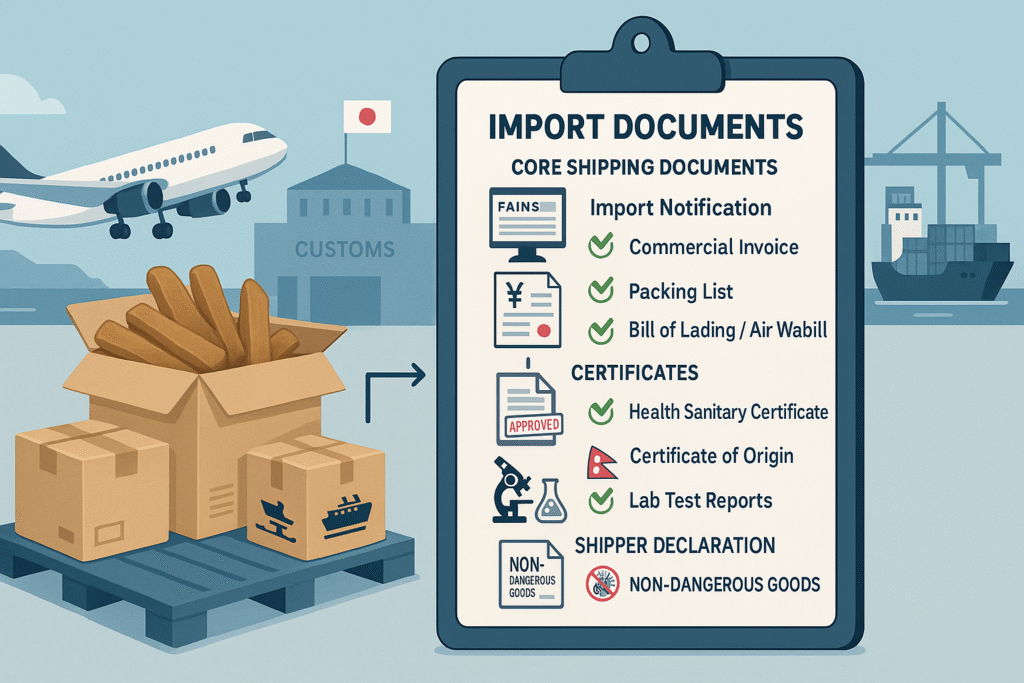
Bringing yak chews into Japan means you’ll need to have your paperwork in order. It’s not just about having the product; it’s about proving it meets all the rules. Think of it like getting a passport for your dog treats. Without the right documents, your shipment might get held up, or worse, sent back. So, let’s break down what you absolutely need to have ready.
Essential Documents for Each Consignment
Every shipment needs a set of core documents. These are the basics that customs and quarantine officials will look for right away. Missing even one can cause a headache.
- Import Notification: This is your heads-up to the Japanese authorities that your yak chews are on their way. You’ll typically submit this through the FAINS system before the product arrives.
- Commercial Invoice: This details the transaction between you and your buyer, including product descriptions, quantities, and prices.
- Packing List: This itemizes exactly what’s in each box or container, making it easier for inspection.
- Bill of Lading or Air Waybill: This is your contract with the shipping company and proof of shipment.
Required Certificates for Import Clearance
Beyond the basic shipping papers, specific certificates are needed to show your yak chews are safe and compliant. These are often issued by government bodies in the country of origin.
- Health Sanitary Certificate: This is a big one. It’s usually issued by the competent authority in the exporting country, confirming that the animal products are safe and free from diseases. For yak chews, this is a non-negotiable item.
- Certificate of Origin: This document verifies where your yak chews were made. It’s important for trade agreements and customs purposes.
- Laboratory Test Reports: Depending on the specific regulations, you might need reports showing that your product meets certain standards, like limits for contaminants or specific nutritional analyses. These reports help demonstrate compliance with Japanese quality standards.
Understanding Shipper Declarations for Non-Dangerous Goods
Most yak chews aren’t considered dangerous goods, but you still need to declare this. This declaration is a formal statement from the shipper confirming that the product does not fall into categories that require special handling or permits due to hazards. It simplifies the process for customs officials, as they know they don’t need to apply extra scrutiny for dangerous cargo. It’s a straightforward way to confirm your product is safe for transport and import under standard procedures. This is also where you might need to reference any certifications related to endangered species, like those covered under CITES regulations, though yak chews typically don’t fall under this category.
“Having all your documentation organized and readily available is the most effective way to avoid delays. It shows you’ve done your homework and respect Japan’s import requirements. Think of it as your product’s visa to enter the Japanese market.”
Wrapping Things Up
So, bringing those tasty yak chews from the Himalayas to Japan might seem like a lot, but it’s totally doable. We’ve gone over the rules, like making sure everything is labeled right and that the chews are safe for our furry friends. Remember to get all your paperwork in order, work with customs folks who know their stuff, and pick the best way to ship them. It takes some effort, sure, but getting these unique, high-quality treats to dog owners in Japan is worth it. With a little planning and attention to detail, you can successfully import these popular chews and keep those tails wagging.
In this part YforYak is a leading manufacturer and exporter of high-quality yak chews, and we understand the complexities of international trade. Our expertise can streamline the process for you, ensuring your products meet all Japanese import regulations and reach your customers without a hitch. Let us handle the logistics and paperwork so you can focus on growing your business.
Frequently Asked Questions
What are the main rules I need to follow to bring yak chews into Japan?
To bring yak chews into Japan, you must follow Japan’s Food Safety and Sanitation Laws, the Japan Agricultural Standards Law, and the Pet Food Safety Law. These rules make sure the treats are safe and good quality for pets. You’ll need to submit import papers and get your products checked.
Do I need to tell the government before my yak chews arrive in Japan?
Yes, you absolutely do. You need to submit an import notification before your yak chews enter Japan. This is usually done through an online system called FAINS. This lets the authorities know what’s coming and that it meets their standards.
Will my yak chews be inspected when they get to Japan?
Definitely. All animal products, including yak chews, must go through a quarantine and inspection process. This is to make sure they are free from any sicknesses or harmful stuff and are safe for pets to eat.
What kind of papers do I need to show when importing yak chews?
You’ll need a bunch of documents. This includes things like an invoice, packing list, and a health certificate from the country you’re shipping from. You might also need test reports and a shipper’s declaration. It’s important to have all these ready for customs.
Is there anything special about how yak chews need to be labeled for Japan?
Yes, labeling is super important. All the labels must be in Japanese and include details like the product name, what’s inside, any allergens, how much there is, and where it came from. The Pet Food Safety Law also has specific rules for what information must be on pet food labels.
How should I ship my yak chews to keep them in good shape?
You can choose between shipping by sea or air, depending on how fast you need them and your budget. It’s crucial to keep the yak chews at the right temperature during shipping, especially if using a refrigerated container. Proper packaging also helps protect the product.

